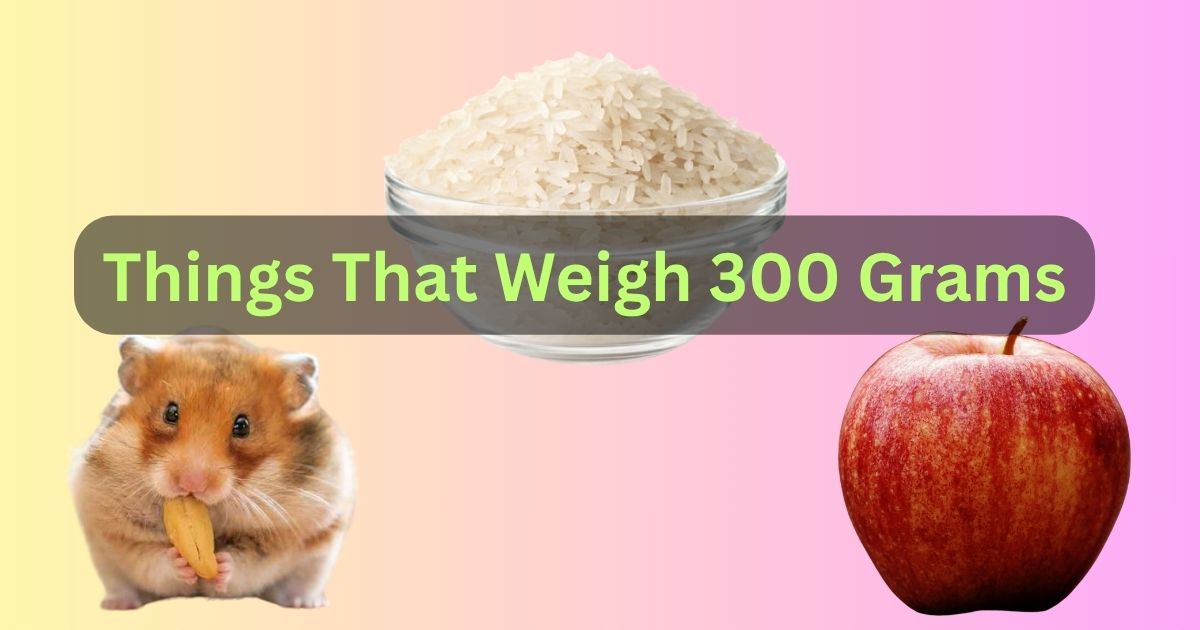300 Grams: Complete Guide With Real Life Examples and Shocking Facts!
300 grams is a unit of mass in the metric system. This is easy to carry and commonly used to measure food, small objects, and personal items. It is equal to 0.3 kilograms, 300,000 milligrams, and 10.58 ounces. In pounds, 300 g is about 0.661 pounds. This weight is approximately the weight of a large apple, a cup of rice, or a small jar of peanut butter. Understanding what 300 grams looks like helps to make smarter food choices and manage portion sizes effectively.
How Much Is 300 grams?
Three hundred grams is a simple measurement that holds significance in various contexts. For instance, in cooking, 300 g is roughly equivalent to about 10.5 ounces. In terms of everyday items, a large apple typically weighs around 300 g. A standard loaf of bread weighs approximately 500 grams, so 300 g would be just over half a loaf.

| Unit | Equivalent of 300 grams |
| Kilograms (kg) | 0.3 kg |
| Pounds (lbs) | 0.661 lb |
| Ounces (oz) | 10.58 oz |
| Milligrams (mg) | 300,000 mg |
| Metric Tons (t) | 0.0003 t |
| Stones (st) | 0.0472 st |
Things That Weigh 300 grams
300g is a common weight that can impact our daily lives in various ways, from our reading habits to our culinary creations. Many everyday items can weigh around this measurement. For instance, a small kitchen scale often weighs about 300 g. This handy tool helps with precise measurements for cooking and baking. A full-sized baseball bat can also weigh around this amount. To visualize this measurement here are a few common objects that weigh 300g.
A Can Of Soup
A standard can of soup typically weighs around 400 to 500 grams. This weight includes the soup itself, the liquid, and the metal packaging. The contents often consist of a mix of vegetables, proteins, and seasonings. Many people appreciate canned soup for its long shelf life, which can range from 1 to 2 years. Canned soup can also be a nutritious choice.
A Large Apple
A large apple typically weighs around 300 g. They have more cells filled with juice. They give a crisp and refreshing quality. They also contain more vitamins and minerals. A single large apple can provide a good amount of fiber, vitamin C, and antioxidants.
A Block Of Cheese
A block of cheese, typically weighing around 200 to 500 grams. It is a versatile ingredient in many kitchens. This form of dairy can be made from cow, goat, or sheep milk and offers distinct flavors and textures. The weight of the cheese can influence its use; for instance, a 250-gram block is perfect for a family gathering, while smaller blocks are ideal for personal snacking or a charcuterie board.
A Paperback Book
A paperback book typically weighs between 200 and 400 grams, depending on its size and the number of pages. This weight is a popular choice for readers who enjoy the tactile experience of holding a book without the bulk of hardcovers. The lightweight nature of paperbacks makes them ideal for travel. They easily fit into bags or backpacks and allow readers to carry their favorite stories wherever they go.
A Cup Of Uncooked Rice
A cup of uncooked rice typically weighs about 300g. This measurement packs a nutritional punch. Rice is a staple food for over half of the world’s population. They provide essential carbohydrates. It serves as a primary energy source, fueling daily activities and promoting overall health.
A Hamster
Hamsters typically weigh between 100 to 250 grams which is only 50 grams less than 300g. The most common types are the Syrian hamster, which can weigh up to 180 grams, and the smaller dwarf hamsters, which usually range from 100 to 150 grams. Their size and weight play a vital role in their care needs. Heavier hamsters may require larger habitats and more space to roam, while lighter ones can thrive in slightly smaller environments.
A Jar Of Peanut Butter (Small Size)
A small jar of peanut butter typically weighs around 340 grams. This size is slightly heavier than 300g and perfect for individuals or small families who want to enjoy the rich, creamy goodness without committing to a larger container. These jars are easy to store in a pantry or even in a backpack for on-the-go snacking. Peanut butter contains healthy fats, protein, and essential vitamins like E and B6.
A Bottle Of Shampoo (Medium Size)
A medium-sized bottle of shampoo typically weighs around 300 to 500 grams. This weight includes the liquid, which is usually around 250 to 400 milliliters, plus the packaging. The design of the bottle plays a crucial role in user experience. Ergonomically shaped bottles are easier to grip and squeeze. Eco-friendly brands opt for lighter packaging materials to reduce the overall weight while maintaining product integrity.
A Bunch Of Bananas (2–3 Medium Bananas)
A bunch of 2–3 medium bananas typically weigh around 300 to 400 grams. These fruits are a convenient snack and are packed with essential nutrients. Bananas are an excellent source of potassium. These are useful for heart health and maintaining normal blood pressure. They also provide vitamin C, vitamin B6, and dietary fiber.
A Coffee Mug Filled With Liquid
A coffee mug filled with liquid typically weighs between 300 to 500 grams. A standard ceramic mug holds about 240 milliliters of liquid, which adds roughly 240 grams to its weight. The weight of a filled coffee mug can impact your drinking experience. Heavier mugs may feel sturdier and offer a sense of quality, while lighter ones can be more comfortable to hold for extended periods.
Conclusion
300 grams is a useful measurement in cooking and nutrition. Understanding the significance of 300 g can enhance daily life. Whether you are measuring ingredients for a recipe or tracking nutrition, knowing this weight is helpful to make better choices. Knowing how to measure 300 grams can make recipes easier to follow. It also helps in maintaining a balanced diet.
FAQs
What is 300 Grams?
300 g is a unit of weight in the metric system. It is approximately 0.3 kilograms or about 10.58 ounces. It is roughly the weight of a large apple or a small loaf of bread. Understanding grams is useful for anyone who follows specific dietary guidelines.
How to Convert 300 grams to Oz?
To convert 300 g to ounces, use a simple formula. One ounce is equal to about 28.35 grams. To find out how many ounces are in 300 g, divide 300 by 28.35. 300 g divided by 28.35 equals approximately 10.58 ounces. So, 300 g is about 10.58 oz.
How Much is 300 Grams in Pounds?
One pound is equal to about 453.6 grams. To find out how many pounds 300g is, divide 300 by 453.6 which is approximately 0.66 pounds. This means 300g of something, weighs a little less than two-thirds of a pound.

